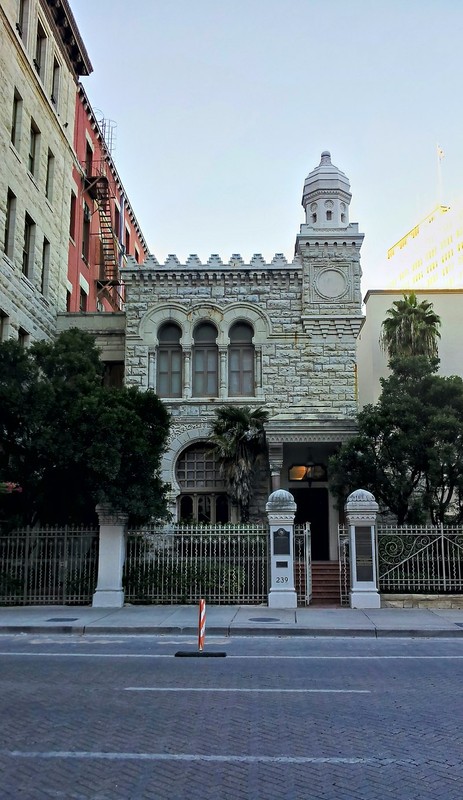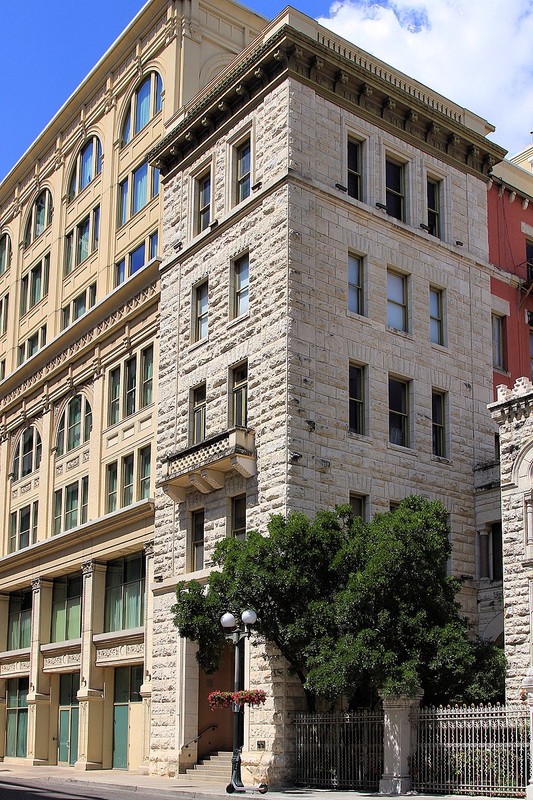First National Bank of San Antonio and San Antonio Loan and Trust Building
Introduction
Text-to-speech Audio
Prominent late 19th and early 20th century businessman and philanthropist, George W. Brackenridge (1832-1920), built the First National Bank of San Antonio and San Antonio Loan and Trust Building in 1886 and 1903, respectively. He established the bank in 1866 as the state's first nationally chartered bank (it was originally called the San Antonio Bank). He founded the loan and trust company in 1892 and lived in the building with his sister, Eleanor. New York architect Cyrus L.W. Eidlitz designed the bank building in the Victorian style and it features Moorish arches and a small corner tower with a minaret. The loan and trust building was also designed in the Victorian style. Both buildings are used for offices today. Brackenridge's philanthropic activities included donating funds to schools and and he also served as regent for the University of Texas from 1886 to 1911 and from 1917 to 1919.
Images
George W. Brackenridge built the First National Bank of San Antonio in 1886.

Brackenridge built the San Antonio Loan and Trust Building in 1903.

Backstory and Context
Text-to-speech Audio
George W. Brackenridge was born in Warwick County, Indiana on January 14, 1832. As a young man, he attended Hanover College, Indiana University, and Harvard University. He and his parents moved to Texas in 1853, settling in Texana. He later worked as a surveyor from 1857 to 1860. As a supporter of the Union during the Civil War, he was ostracized and could not stay in Texas. He was appointed as a U.S. Treasury agent in 1863 and worked in New Orleans for the Treasury Department after the Union captured the city. In 1866, he moved to San Antonio and, as noted above, established the bank. He also founded a cotton company with partner to sell former Confederate cotton his father seized. The need for businessmen (cattle barons, railroad investors, etc.) to receive support and legal advice for their ventures prompted Brackenridge to establish the San Antonio Loan and Trust Company in 1892 (the federal government did not allow national banks from offering trust services at the time).
Brackenridge became involved in a variety of activities and roles including serving as the president of the San Antonio Water Works Company from 1883 to 1906 and as the president of the San Antonio Express Publishing Company. He also served on the local school board. He is perhaps most well known for his tenure as regent of the University of Texas. Among his many activities as regent, he provided educational funds for women and minorities (he encouraged hiring women faculty members as well). His educational philanthropy extended outside of San Antonio too. A few examples include providing the funds to build a dorm for the first women medical students in Galveston, and acquiring 500 acres for the University of Austin.
Brackenridge never married and died on December 28, 1920. He was buried in his family's cemetery in Jackson County, Texas. Most of his fortune went to the George W. Brackenridge Foundation. As for the two buildings, the bank was eventually acquired by First National Bank, which appears to have occupied it until the early 1970s. The San Antonio Loan and Trust building became an office building as well but exactly when is unclear. Both buildings are listed separately on the National Register of Historic Places.
Sources
Bell, Wayne. "First National Bank of San Antonio." National Park Service - National Register of Historic Places Nomination Form. March 16, 1972. https://s3.amazonaws.com/NARAprodstorage/opastorage/live/71/9711/40971171/content/electronic-records/rg-079/NPS_TX/72001348.pdf.
“Brackenridge, George Washington.” Handbook of Texas Online. Accessed March 28, 2023. https://www.tshaonline.org/handbook/entries/brackenridge-george-washington.
Hardy, Daniel & Williams, Joe. "San Antonio Loan and Trust Building." National Park Service - National Register of Historic Places Nomination Form. July 12, 1976. https://s3.amazonaws.com/NARAprodstorage/opastorage/live/61/9711/40971161/content/electronic-records/rg-079/NPS_TX/76002006.pdf.
Both images via Wikimedia Commons
